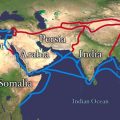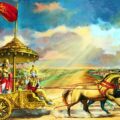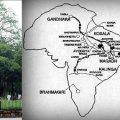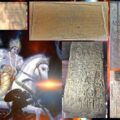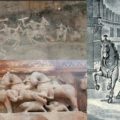Grand Trunk Road since Pre Mahabharata Times; Here are Evidences
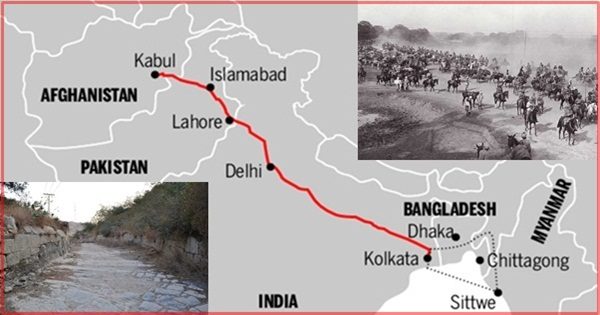
So, we have read in school that Sher Shah Suri built the Grand Trunk Road. GK competitions including all academic and media narratives proclaim this. I blindly believed this narrative to be true during my academic days and later. But the truth about the Grand Trunk Road is different. We have been taught only a one-sided and distorted narrative. This road, South Asia’s one of the oldest and longest, that connects India with Bangladesh, Pakistan, and Afghanistan, existed since pre-Mahabharata times.
The Mahabharata finds mention about this route. Mauryan records describe this ancient road; the rulers rebuilt it. Magasthenes, the Greek Ambassador to India in ancient times, wrote in his book Indica about this route that also mentions about the vital link created in terms for trade and communication. This road has been rebuilt and expanded over a period of several thousand years. Then why the name of Sher Shah Suri as the builder? It is true that Sher Shah Suri renovated this route and beautified it, planting trees on both sides. But centuries ago, Ashoka beautified the same road, planting trees on both sides, building wells and resthouses for the travelers. Ashoka also erected pillars and edicts including kos minars in this route. Why all the credit to Sher Shah Suri? The narrative should have been like this – Sher Shah Suri ‘renovated the ancient Grand Trunk Road’ NOT ‘built the Grand Trunk Road’. So GT Road is even known as Gernaili Sadak, Badshahi Sadak, and Sadak-e-Azam coined in the 16th century during the reign of Sher Shah Suri and Mughal period!
Here are few websites and tweet that deem Sher Shah Suri as the builder of this road:
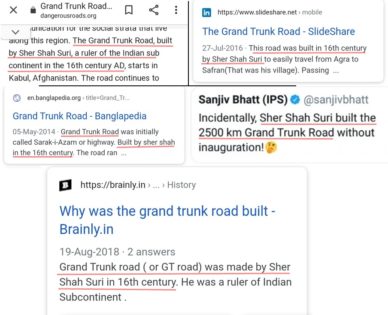
Who was Sher Shah Suri? An ethnic Afghan Pashtun and born as Farid Khan Lodhi, Sher Shah Suri was a a commander in the Mughal army under Babur and later became the governor of Bihar. During Humayun’s reign, he proclaimed himself as Sultan of Bengal and his territory comprised of Bihar, parts of Bengal and other parts of northern India. He established the Suri dynasty with capital in Sasaram in present-day Bihar.
Sher Shah Suri ruled for seven years, from 1538 to 1545. During this period he renovated and expanded the Grand Trunk Road. It is impossible to build, in a span of seven years, a route that covered around 2,400 kilometers connecting Chittagong to Kabul touching Lahore, Amritsar, Allahabad, Delhi, Howrah.
Presently, Grand Trunk Road coincides with current N1, N4, N405, N507, N6, NH 12, NH 27, NH 19, NH 44, NH 3, N5, AH1 spanning India, Pakistan, Afghanistan, and Bangladesh. Following is an account of evidences that prove this route existed since thousands of years before the time of Sher Shah Suri.
In ancient India, some thousands of years ago, Grand Trunk Road was known as Uttarapatha (meaning northern route). The Ramayana and Mahabharata events are historical. Ayodhya Raja Dasharath’s wife Kaikeyi was from the Kekaya kingdom, parts of present Afghanistan. Her son Bharat, the brother of Shri Ram, conquered the Gandhara kingdom, also in Afghanistan; laid the foundation of Takshashila city. This is evidence of the existence of a route that connected Ayodhya with Afghanistan. Gandhari in the Mahabharata was from the Gandhara kingdom, which also proves there was a road connecting Afghanistan with Hastinapura. Besides this, the Mahabharata finds mention of Uttarapatha that connected the territories of the Kirata kingdom with Gandhara, Kamboja (beyond Gandhara) and Yavana (Greek) countries. Prakash Chandra Prasad in his book Foreign Trade and Commerce in Ancient India also mentions about this ancient route depicted in the Mahabharata citing trade and commerce relations.
Nayanjot Lahiri in his book The Archaeology of Indian Trade Routes up to c 200 BC describes how the Uttarapatha connected with a network of ‘multiple feeder routes…intertwined with the major axis’. This is quoted by Jason Neelis in his book Early Buddhist Transmission and Trade Networks: Mobility and Exchange Within. In Page No 185, Neelis in this book has featured the Uttarapatha route in a map of trade networks in ancient South Asia. Here is the map:
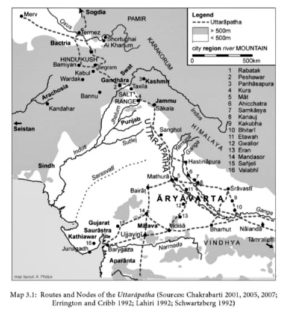
The ancient Uttarapatha route connected the northern part of Bharat with numerous South Asian nations. This facilitated both cultural and commercial exchange between the regions. This route covered Bactria in northern Afghanistan to western Central Asia to the Gangetic basin in northern India to Mathura. It spanned the whole of Northern India, connecting Gandhara in the north-west to Anga in the east to the Himalayas in the north. According to few scholars, this route also connected to Vindhya in the south. This route was used for international trade. Besides exchange of commodities and talents, this route also facilitated dissemination of knowledge and technology. Puranas mention the region to the south of Uttarapatha as Madhyadesa, which also finds mention as Jambudvipa region according to few texts. Besides literary evidences, there are archaeological and epigraphical evidences that corroborate the existence of Uttarapatha in ancient India. Ancient Grand Trunk Road also connected with the Silk Road (also called Silk Route), a network of trade routes that connected the East with the West.
Again to quote Jason Neelis, “Uttarapatha was the main artery of commercial and cultural exchange between the northwestern borderlands of South Asia and the Ganga-Yamuna doab in northern India…. Uttarapatha commonly designates the “North Country” or “Northern Region” encompassing territories from the Gangetic basin in northern India to Mathura, and Bactria in northern Afghanistan and western Central Asia…. Archaeological evidence from the middle of the first millennium BCE amply demonstrates long-distance connections and continuities in material culture throughout the northern Indian subcontinent. The development of arterial networks for the dissemination of material culture and commodities through interregional trade exchanges was closely linked with the growth of cities in the northern subcontinent. A characteristic feature of this cultural assemblage was Northern Black Polished (NBP) ware pottery beginning around 550-400 BCE and continuing until about 100 BC. Nonlocal materials including lapis lazuli from Badakhshan (northeastern Afghanistan), sandstone from Mathura, and precious stones such as topaz and amethyst provide evidence for the transport of certain raw materials over long distance”.
The Grand Trunk Road was also termed Royal Road in ancient times. When Megasthenes was in India as a Greek Ambassador, he, using this route ‘travelled into lands never before beheld by Greek eyes”. The Royal Road impressed Megasthenes. According to the Greek ambassadors’ own account, this route connected the far end of the ancient northern Indian empire from Petrushpur to Takshashila, from Hastinapur to the Ganges, also touching base of Sutlej and Jhelum, from Pataliputra to Tamlak. Here is an extract from Monograpgh No 1: The Grand Trunk Road in the Punjab by KM Sarkar, a Punjab govt record on the Grand Trunk Road during the time of Megasthenes:
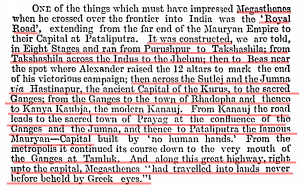
Chandragupta Maurya further renovated, revamped, and expanded the Uttarapatha. He deployed officials to oversee the maintenance of the road. This ancient route during the Mauryan period facilitated trade relations of the neighboring kingdoms.
Further improvements to the ancient Grand Trunk Road were done by Ashoka. He beautified the route by planting trees on both sides to the benefit of travelers. He also built wells at every half ‘kos’. According to Chanakya’s Arthashastra, 1 kos is equal to 1.91 miles or 3075 metres. Ashoka also built resthouses along the route to the advantage of the travelers. He recorded in his edicts about the same. Monograpgh No 1: The Grand Trunk Road in the Punjab by KM Sarkar also describes Samudragupta’s and Ashoka’s contribution to the renovation, maintenance, expansion and beautification of the Uttarapatha. Here is an extract.

What Ashoka did in ancient India along the Grand Trunk Road then was what Sher Shah Suri did thousands of years later. While our historical texts and colonial historians date the Mauryan period to be between 322 and 187 BCE (i.e. flourished some 2300 years ago), according to the book Chronology of India by Shri Vedveer Arya, Mauryas flourished between 1516-1217 BCE (3500 years ago). His historical datings are based on Puranas, archaeological evidences, epigraphical and inscriptional records, literary and other sources. So, going by this calculation, Ashoka undertook beautification of the Uttarapatha, planting trees, building wells and resthouses along the route some 3300 years ago! Here is a map of Bharat that features the edicts of Ashoka:
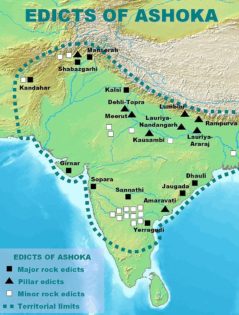
Edicts and Pillars of Ashoka along Grand Trunk Road (Uttarapatha) and Dakshinapatha; Image source: Wikipedia.
If Megasthenes visited India around 300 BCE and if Chandragupta Maurya ruled from 1516 BCE then who was the Indian emperor of Magadh that the Greek ambassador refered to? It is a lengthy account but without citing evidences with references, the fact cannot be proved at face value. Chronology of India by Vedveer Arya provides the answers and solves the chronology citing various evidences. According to historical records, Megasthenes stayed in India for several years at the court of Sandrokottus in Polibothra. Who was Sandrokottus? Colonial and many Indian historians identified Sandrokottus with Chandragupta Maurya and thousands of historical records written centuries later, recorded this fake assumption to be true. Puranas clearly indicate that Mahapadma Nanda founded his Nanda dynasty 1500 years after the Mahabharata war. And Chandragupta Maurya, with the help Chanakya, defeated Mahapadma Nanda. The errors in Indian chronology, in fact,world chronology (which is taken into account before and after Christ of 1 CE) is a result of the false dating of Buddha Nirvana and birth year of Christ. To quote Vedveer Arya, “Evidently, the traditional chronology places Buddha in the 19th century BCE and Chandragupta Maurya in the beginning of the 16th century BCE. When colonial historians identified Sandrokottus with Chandragupta Maurya and dated him as the contemporary of Alexander, they started questioning the authenticity of the traditional chronology…. Jain historians inadvertently identified Ujjain King Chandragupta, a disciple of Bhadrabahu with the Maurya King Chandragupta which made Mahavira, a contemporary of Buddha. In reality, Buddha attained nirvana 675 years before the year of Mahavira nirvana. Puranas and the Burmese inscriptions clearly indicate that Buddha attained nirvana in 1864 BCE. Recent excavations at Lumbini and the radiocarbon samples collected from the Trench C5 at the center of the Buddhist shrine at Lumbini indicate an earliest date of 1681 BCE…. Greek historians like Megasthanes, Plutarch, Strabo, Pliny, Justin and Arrian mention an Indian king named ‘Sandrokottus’ who was the contemporary of Alexander and Seleucus Nicator. William Jones (1746-1794 CE) was the first who identified ‘Sandrokottus’ with Chandragupta Maurya. Modern historians have blindly propounded this identification as the sheet anchor of Indian chronology.”
Megasthenes and Greek historians mention Polibothra as the capital city base of king Sandrokottus – located close to the confluence of Ganges and Errannaboas (Yamuna). Is Polibothra Pataliputra? There were numerous kings by the name of Chandragupta. According to Chronology of India, confluence of Ganga and Yamuna rivers takes place at Prayaga close to Prayagabhadra or Pratisthanapura. Hence, Polibothra is Prayagabhadra. The same book by Arya identifies Sandrokottus with King Chandragupta, the son of Xandremes or King Chandra that finds mention in the Iron Pillar inscription on the hill of Vishnupada. This king ruled from 984-930 BCE. Thus, dating of Megasthenes to around 300 BCE is also faulty. Megasthenes was in India around 984-930 BCE. The error in chronology here is again because of the wrong dating of the birth year of Jesus. The dates of Alexander and Seleucus have been arrived based on the epoch of the Christian era (1 CE). Vedveer Arya in his book The Origin of the Christian Era: Fact or Fiction writes that the epoch of the Christian era (1 CE) was just a fictitious epoch of Easter calculus. Based on the archaeo-astronomical study of the Venus Tablet, the Sothic cycles, the epochs of Olympiad, foundation of Rome city and the epoch of the Nabonassarian era, Vedveer Arya arrives at 660 BCE as birth year of Jesus and not in 1 CE. Here is an extract from Chronology of India Vol 1, Book 2:
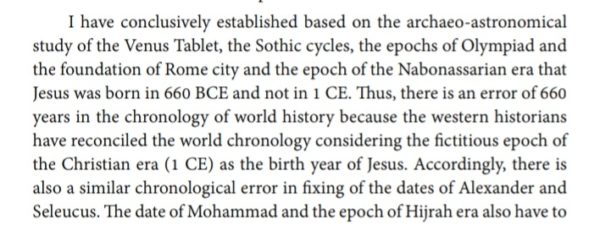
According to the same account, Alexander reigned over Macedonia, Egypt and Persia around 990-982 BCE. Thus the Uttarapatha – the ancient Grand Trunk Road that Megasthenes mentions actually dates back to nearly 3000 years!
Raja Kanishka undertook maintenance of the Uttarapatha. Over the years, many rulers of subsequent dynasties who ruled the northern belt of India undertook the responsibility of maintaining this route. After independence, the road and more roads of the country are maintained by the govt. It is time school textbooks and mainstream media project the right history of Grand Trunk Road. Sher Shah Suri, like many rulers spanning centuries and thousands of years before him, only beautified, maintained and expanded the existing route.
Ref:
1. Early Buddhist Transmission and Trade Networks: Mobility and Exchange Within by Jason Neelis
2. Monograpgh No 1: The Grand Trunk Road in the Punjab by KM Sarkar
3. Chronology of India, Vol 1, Book 2 by Vedveer Arya
4. More references cited in the above article itself.

